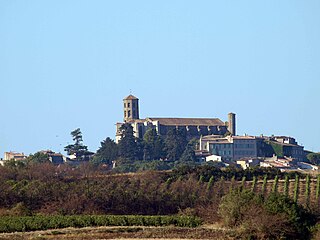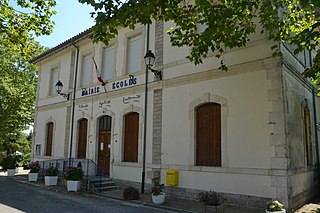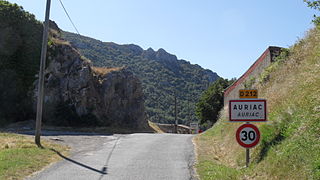
Le Caunil is a hamlet in the Aude department of the Occitanie region in France. It forms part of the commune of Salvezines.

Le Caunil is a hamlet in the Aude department of the Occitanie region in France. It forms part of the commune of Salvezines.
Le Caunil is situated at 850 metres above sea level, on the slopes of the Pyrenees above Salvezines and a few kilometres south-west of Château de Puilaurens, one of the famous Cathar castles dotting the region. The hamlet lies beneath a set of craggy cliffs and a forested plateau, and is a point of departure for the Forêt d'en Malo [1] hiking trail.
Le Caunil has a small church as well as a school that is no longer in use.
The area between Le Caunil and Salvezines has significant deposits of feldspar, [2] a raw material used in the ceramic industry, which has previously been mined from open quarries. There are several artisans with workshops in Le Caunil and the surrounding area.
In the 10th century, the church in Le Caunil was under the authority of the nearby Abbey of Saint-Martin-Lys. [3]

Ariège is a department in southwestern France, located in the region of Occitanie. It is named after the river Ariège and its capital is Foix. Ariège is known for its rural landscape, with a population of 153,287 as of 2019. Its INSEE and postal code is 09, hence the department's informal name of le zéro neuf. The inhabitants of the department are known as Ariègeois or Ariègeoises.

Haute-Garonne is a department in the southwestern French region of Occitanie. Named after the river Garonne, which flows through the department. Its prefecture and main city is Toulouse, the country's fourth-largest. In 2019, it had a population of 1,400,039.

Montréal is a commune just west of Carcassonne in the Aude department, a part of the ancient Languedoc province and the present-day Occitanie region in southern France.

The arrondissement of Perpignan is an arrondissement of France in the Pyrénées-Orientales department in the Occitanie region. It has 39 communes. Its population is 292,142 (2021), and its area is 720.5 km2 (278.2 sq mi).

Abos is a commune in the Pyrénées-Atlantiques department in the Nouvelle-Aquitaine region in southwestern France.

Couiza is a commune in the Aude department in southern France. Couiza is a rural commune which has 1,122 inhabitants in 2020. It belongs to the urban unit of Espéraza. Its inhabitants are called Couizanais or Couizanaises.

Arques is a commune in the Aude department in the Occitanie region of southern France.

Lagrasse is a commune in the Aude department in the Occitanie region of Southern France. Lagrasse is part of the Les Plus Beaux Villages de France association.

Aleu is a commune in the Ariège department in the Occitanie region of southwestern France.

Airoux is a commune in the Aude department in the Occitanie region of southern France.

Ajac is a commune in the Aude department, part of the Occitanie region, southern France.

Alaigne is a commune in the Aude department in the Occitanie region of southern France.

Nébias is a commune in the Aude department in southern France. Its inhabitants are called Nébiassais.
Salvezines is a commune in the Aude département in southern France. It includes the village of Salvezines and the hamlet of Le Caunil.

Seignalens is a commune in the Aude department in the Occitanie region of southern France.

Auriac is a commune in the Aude department in the Occitanie region of southern France.

Puilaurens is a commune in the Aude department in southern France.

Pyrénées-Orientales, also known as Northern Catalonia, are a department of the region of Occitania, Southern France, adjacent to the northern Spanish frontier and the Mediterranean Sea. It borders the departments of Ariège to the northwest and Aude to the north, the Mediterranean Sea to the east and the Spanish province of Girona in Catalonia to the south and the country of Andorra to the west. It also surrounds the tiny Spanish exclave of Llívia, and thus has two distinct borders with Spain. In 2019, it had a population of 479,979. Some parts of the Pyrénées-Orientales are part of the Iberian Peninsula. It is named after the Pyrenees mountain range.

The canton of La Haute-Vallée de l'Aude is an administrative division of the Aude department, southern France. Its borders were modified at the French canton reorganisation which came into effect in March 2015. Its seat is in Quillan.

The French Great South-West is a geographical, sociological, economic and cultural entity bringing together the administrative regions of Nouvelle-Aquitaine and Occitanie, resulting from the merger on January 1, 2016, of five previous regions; in these two regions combined, it covers 156,000 km2, or 29% of the territory of metropolitan France. It is a grouping devoid of its own political or administrative structures, set up, with the objective of an interregional reflection on spatial planning at the level of new European issues, at the initiative of the Interministerial Delegation at territory planning and regional attractiveness.
42°46′49″N2°17′37″E / 42.78028°N 2.29361°E